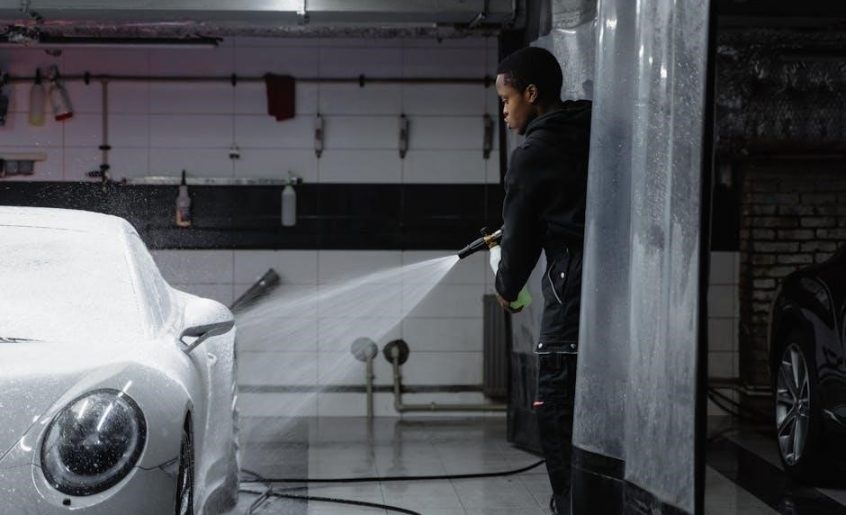Welcome to the Ryobi Pressure Washer Manual, your comprehensive guide to understanding and operating your pressure washer effectively. This manual covers models like RY80030 and RY142022, offering detailed instructions for optimal performance and safety.
1.1 Overview of the Ryobi Pressure Washer
The Ryobi Pressure Washer is a high-performance cleaning tool designed for efficiency and durability. Available in models like the RY80030 (3000 PSI, 2.3 GPM) and RY142022 (2000 PSI, 1.2 GPM), these units cater to both residential and light-commercial use; Engineered for reliability, they feature robust construction, easy-to-use controls, and integrated detergent tanks for versatile cleaning tasks. Whether tackling driveway stains, siding, or outdoor furniture, Ryobi pressure washers deliver consistent results. Their compact designs and user-friendly interfaces make them accessible for homeowners and professionals alike, ensuring optimal cleaning power with minimal effort.
1.2 Importance of Reading the Manual
Reading the Ryobi Pressure Washer manual is crucial for safe and effective operation. It provides essential safety guidelines, assembly instructions, and maintenance tips to ensure optimal performance. The manual details proper usage of nozzles, detergent application, and troubleshooting common issues. By following the manual, users can avoid hazards, extend the product’s lifespan, and maintain warranty coverage. It serves as a comprehensive guide, empowering users to handle the pressure washer confidently and efficiently. Always refer to the manual before operating the unit to ensure a safe and successful cleaning experience.
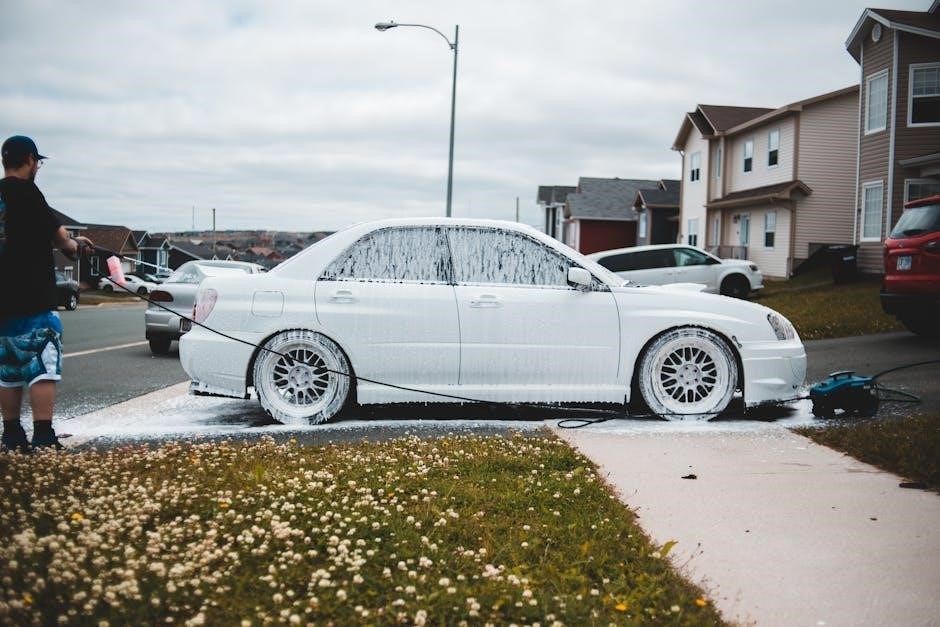
Safety Precautions
Always wear protective gear like goggles and gloves. Avoid spraying flammable materials or electrical components. Keep children and pets away from the operating area for safety.
2.1 General Safety Guidelines
Always read the manual thoroughly before operating the Ryobi pressure washer. Wear protective gear, including gloves and safety goggles, to prevent injury. Ensure the area is clear of debris and flammable materials. Never operate the washer near open flames or sparks. Keep children and pets away from the machine while in use. Avoid using the pressure washer in wet conditions to prevent slipping. Regularly inspect the hose, wand, and nozzles for damage; Follow all safety instructions provided in the manual to ensure safe and effective operation. Proper maintenance and care will extend the life of your pressure washer.
2.2 Specific Hazards to Avoid
Avoid using the pressure washer near electrical outlets or appliances to prevent electrical shock. Do not aim the nozzle at people, pets, or windows to avoid injury or damage. Never use the washer while standing on a ladder or unstable surface. Keep the pressure washer and its components away from open flames or sparks, as some parts may contain flammable materials. Do not modify the machine or use unauthorized attachments, as this can lead to malfunction. Always turn off the engine and allow it to cool before performing maintenance or repairs. Be cautious of high-pressure streams, which can cause serious injury or damage to surfaces.
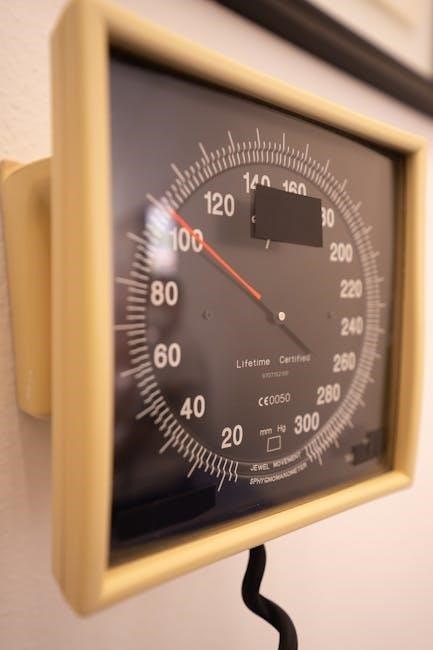
Assembly and Installation
Begin by unpacking and inventorying all parts. Follow step-by-step instructions for assembling the frame, attaching the spray wand, and connecting hoses. Properly align and secure components. Ensure all connections are tight and leak-free. Refer to the manual for specific torque values and safety precautions. After assembly, inspect the unit and ensure it is ready for initial use. Always follow safety guidelines during setup and operation.
3.1 Unpacking and Inventory of Parts
Begin by carefully opening the box and inspecting for any damage. Remove all components, including the frame, engine, hoses, spray wand, nozzles, and detergent tank. Check the packing list to ensure all parts are included. Compare the items with the manual’s parts diagram to confirm completeness. Pay attention to small hardware like bolts, washers, and adapters. If any part is missing or damaged, contact customer support immediately. Proper inventory ensures smooth assembly and prevents delays. Handle components with care to avoid damage. Store all parts in a safe, organized manner for easy access during assembly.
3.2 Step-by-Step Assembly Instructions
Start by attaching the handle to the frame using the provided bolts, ensuring it is securely tightened. Next, connect the high-pressure hose to both the pump and the spray gun, making sure all fittings are tightly sealed. Attach the spray wand to the gun, ensuring it clicks into place. Install the desired nozzle by pulling and twisting until it locks. Finally, attach the detergent tank to the designated area on the frame. Double-check all connections for tightness and inspect for any leaks before initial use. Refer to the diagram in the manual for visual guidance.
3.3 Initial Setup and Preparation
Place the pressure washer on a level surface and ensure all components are securely attached. Check all connections for leaks by gently tugging on hoses and fittings. If using detergent, fill the tank with the recommended solution. Ensure the water supply is clean and free from debris. Prime the pump according to the manual to prevent damage. Test the spray gun and nozzles by pulling the trigger to ensure proper water flow. Review the safety guidelines and operating instructions before starting. Refer to the manual for specific setup requirements for your model, such as RY80030 or RY142022, and ensure all precautions are followed.
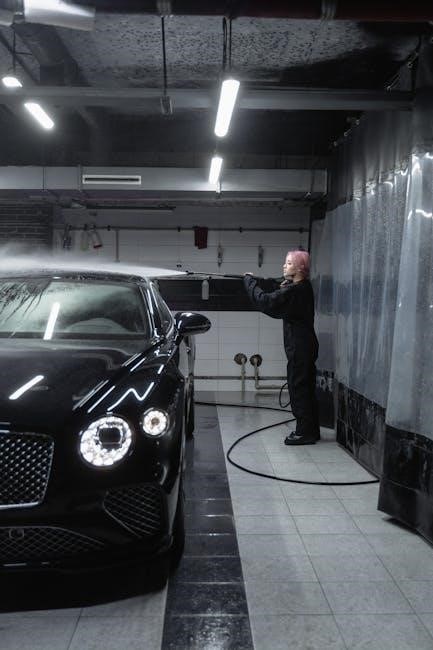
Operating Instructions
Start the engine, adjust pressure settings, and select the appropriate nozzle tip for your cleaning task. Apply detergent if needed and move the spray wand steadily to ensure effective cleaning.
4.1 Starting the Pressure Washer
To start your Ryobi pressure washer, ensure the oil and fuel levels are adequate for gasoline models. For electric models, plug into a grounded outlet. Check all connections and hoses for leaks. Prime the pump if necessary, then set the choke to the “start” position. Pull the starter cord firmly until the engine ignites. Allow it to warm up briefly before adjusting pressure settings. Always ensure the area is clear of debris and wear protective gear. Refer to your specific model’s manual for detailed starting procedures. Proper starting ensures efficient and safe operation.
4.2 Using Different Nozzle Tips
Your Ryobi pressure washer comes with interchangeable nozzle tips, each designed for specific cleaning tasks. The 0° nozzle is ideal for heavy-duty cleaning and stripping surfaces, while the 25° and 40° nozzles are better for general cleaning and delicate surfaces. The soap nozzle is used for applying detergent. Always use the correct nozzle for the job to ensure efficiency and avoid damage. To change nozzles, pull and twist the current tip until it releases, then secure the new one firmly. Never use a damaged or worn-out nozzle, as it may reduce performance or cause injury.
4.3 Applying Detergent and Cleaning Solutions
To effectively use detergent with your Ryobi pressure washer, fill the designated soap tank with a recommended cleaning solution. Attach the soap nozzle to the spray wand, ensuring it clicks securely into place. With the pressure washer running at low pressure, squeeze the trigger to dispense the detergent evenly onto the surface. Allow the solution to sit for a few minutes before rinsing thoroughly with clean water. Always use detergent specifically designed for pressure washers to avoid damaging surfaces or the machine. Follow the manufacturer’s instructions for the correct dilution ratio to ensure optimal cleaning results and machine longevity.
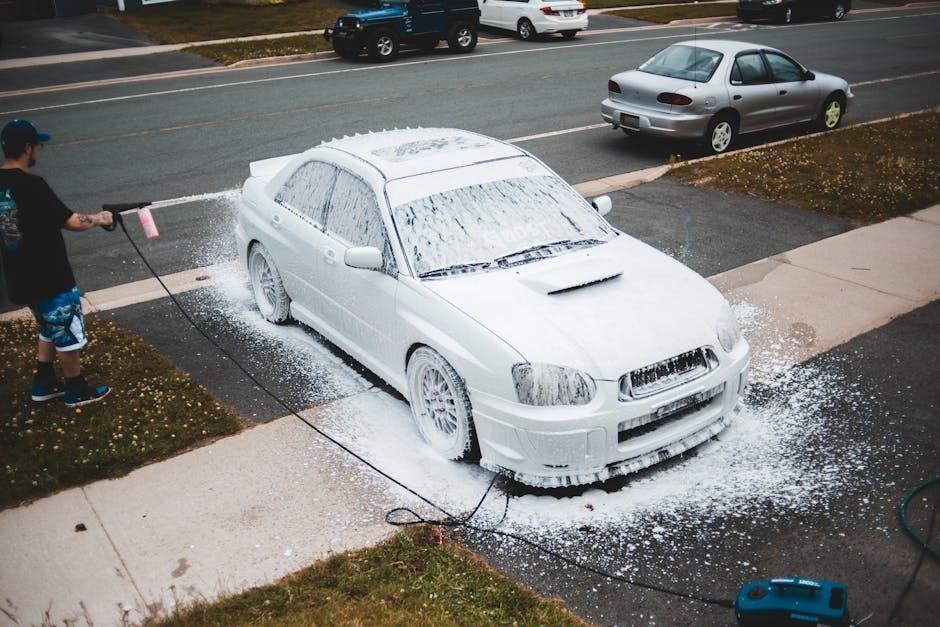
Maintenance and Care
Regular maintenance ensures optimal performance. Check for wear, store properly, and winterize to prevent damage. Inspect hoses and connections regularly for leaks or damage. Follow guidelines for longevity.
5.1 Routine Maintenance Checks
Perform routine checks to ensure your Ryobi pressure washer operates efficiently. Inspect hoses and connections for leaks or damage. Check the pump oil level, ensuring it’s filled to the recommended level to prevent overheating. Clean or replace the filter regularly to maintain water flow. Additionally, examine the high-pressure wand and nozzles for blockages or wear. Lubricate moving parts as specified in the manual to reduce friction and wear. Always follow the manufacturer’s guidelines for replacement parts and maintenance schedules to extend the lifespan of your pressure washer.
5.2 Storage and Winterization
Proper storage and winterization are crucial to maintain your Ryobi pressure washer’s performance. After the cleaning season, drain all water from the hoses, pump, and tank to prevent freezing. Use a pressure washer antifreeze solution to protect internal components. Store the unit in a dry, cool place, away from direct sunlight. Remove and store hoses and accessories separately to prevent damage. Inspect for any necessary repairs before storage. Follow these steps to ensure your pressure washer remains in optimal condition for the next use.
5.3 Troubleshooting Common Issues
Your Ryobi pressure washer manual provides a detailed troubleshooting guide to address common issues. If the unit doesn’t start, check the spark plug, oil level, and fuel supply. Low pressure may indicate a clogged nozzle or worn seals. Leaks often result from loose connections or damaged hoses. Refer to the manual for specific solutions and DIY repair tips. Regular maintenance, such as inspecting hoses and replacing worn parts, can prevent many problems. Always follow the recommended troubleshooting steps to ensure safety and optimal performance of your pressure washer.

Technical Specifications
Explore the technical details of your Ryobi pressure washer, including PSI, GPM, and model-specific features like RY80030 and RY142022, ensuring optimal performance for your cleaning tasks.
6.1 Pressure Washer Models (e.g., RY80030, RY142022)
Ryobi offers a range of pressure washer models, including the RY80030 and RY142022, designed for various cleaning tasks. The RY80030 is a 3000 PSI gas-powered model, ideal for heavy-duty use, while the RY142022 is a 2000 PSI electric model, suitable for lighter applications. Both models are known for their durability and ease of operation. Each model comes with specific features tailored to its power source and intended use. Refer to the respective manuals for detailed specifications and operation guidelines. These models are widely popular among homeowners and professionals for their reliability and performance.
6.2 Performance Metrics (PSI, GPM, etc.)
Ryobi pressure washers are characterized by their impressive performance metrics. Models like the RY80030 deliver 3000 PSI and 2.5 GPM, making them suitable for tough cleaning jobs. The RY142022 offers 2000 PSI and 1.2 GPM, ideal for lighter tasks. These metrics ensure efficient cleaning power, balancing pressure and flow rate for optimal results. Higher PSI models are better for heavy-duty applications, while lower PSI models are perfect for home use. Understanding these metrics helps users choose the right model for their needs, ensuring effective and efficient cleaning performance across various surfaces and tasks.
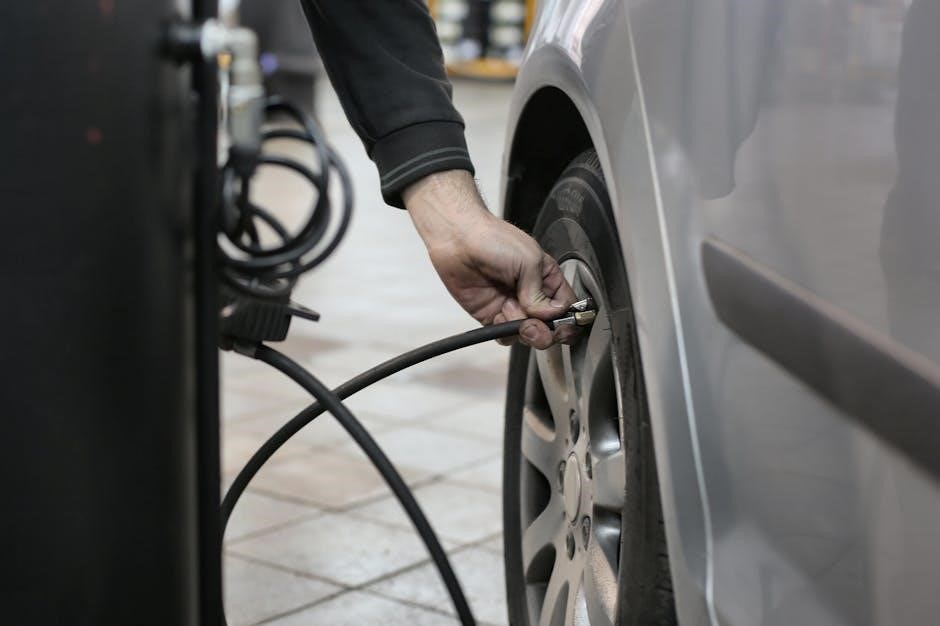
Troubleshooting Guide
Identify common issues like low pressure or pump malfunction. Refer to the manual for quick fixes or contact Ryobi support for professional assistance and resolution.
7.1 Common Problems and Solutions
Common issues with Ryobi pressure washers include low water pressure, pump malfunction, or clogged nozzles. For low pressure, check hoses for kinks or blockages and ensure the water supply is adequate. If the pump fails, refer to the manual for priming instructions or replace worn seals. Clogged nozzles can be cleaned with a small brush or replaced if damaged. Regular maintenance, such as lubricating moving parts and storing the unit properly, helps prevent these issues. Always consult the manual for specific troubleshooting steps or contact Ryobi customer support for further assistance.
7.2 DIY Repair Tips
For minor issues, DIY repairs can save time and money. If your Ryobi pressure washer has low water pressure, check for kinks in the hose or blockages in the nozzle. Clean or replace the nozzle as needed. For pump issues, ensure it is properly primed and lubricated. If the motor overheats, allow it to cool before restarting. Regularly inspect and replace worn seals or gaskets to maintain performance. Always use genuine Ryobi parts for replacements. If unsure, consult the manual or contact customer support for assistance. Proper tools and safety precautions are essential for successful DIY repairs.

Warranty and Support
Ryobi pressure washers come with a comprehensive warranty covering parts and labor for a specified period. Contact customer support for assistance or to locate authorized service centers near you.
8.1 Warranty Coverage and Duration
Ryobi pressure washers are backed by a limited warranty that covers defects in materials and workmanship. The warranty period typically ranges from 3 to 5 years, depending on the model and usage conditions. Coverage begins from the date of purchase and applies only to the original owner. The warranty does not cover damage caused by misuse, neglect, or normal wear and tear. For specific details, refer to the official Ryobi website or contact customer support. Proper maintenance and adherence to manual guidelines are essential to ensure warranty validity. Authorized service centers handle warranty repairs to maintain product integrity.
8.2 Contacting Customer Support
For assistance with your Ryobi pressure washer, contact customer support through phone, email, or live chat on the official Ryobi website. Visit the “Support” section for contact details and additional resources. When reaching out, have your model number and purchase details ready for efficient service. The support team is available to address warranty claims, troubleshooting, and general inquiries. For quicker resolution, ensure you provide clear descriptions of any issues encountered. Ryobi’s customer support is committed to helping you maintain your pressure washer’s performance and resolve any concerns promptly.

Environmental Considerations
Use eco-friendly detergents and dispose of chemicals properly to minimize environmental impact. Follow guidelines for responsible water usage and waste disposal to protect the environment.
9.1 Eco-Friendly Usage Tips
To minimize environmental impact, use eco-friendly detergents specifically designed for pressure washers. Avoid harsh chemicals that can harm plants or waterways. Opt for biodegradable solutions whenever possible. Regularly inspect and maintain your pressure washer to prevent leaks and waste water. Use the correct nozzle size to avoid excessive water usage. Consider using electric models, as they emit fewer fumes compared to gas-powered units. Always follow local regulations for water and chemical disposal. By adopting these practices, you can reduce your environmental footprint while effectively cleaning surfaces.
9.2 Proper Disposal of Chemicals
Always dispose of pressure washer detergents and cleaning solutions responsibly. Check local regulations for hazardous waste disposal facilities. Never pour chemicals down drains or stormwater systems, as they can harm aquatic life. Use biodegradable and phosphate-free detergents whenever possible. Store leftover chemicals in their original containers and ensure they are tightly sealed. Dispose of empty containers according to local guidelines. For safety, wear gloves and protective eyewear when handling chemicals. Proper disposal helps protect the environment and ensures compliance with waste management laws. Refer to your local waste management agency for specific instructions on handling cleaning agents.
This concludes the manual. Follow guidelines for optimal performance and safety, ensuring your Ryobi Pressure Washer’s longevity and efficiency for the best experience.
10.1 Final Tips for Optimal Performance
To maximize your Ryobi Pressure Washer’s efficiency, always use recommended nozzles and detergents. Regularly inspect hoses and connections for wear, addressing issues promptly. Maintain proper storage, especially during winter, to prevent damage. Follow the maintenance schedule outlined in the manual to ensure longevity. Using genuine Ryobi parts for repairs guarantees compatibility and performance. Eco-friendly practices, like minimizing water usage, enhance sustainability. By adhering to these tips, you’ll enjoy consistent, reliable cleaning power for years to come. Remember, proper care is key to optimal performance and safety.
10.2 Encouragement to Follow Manual Guidelines
Adhering to the guidelines in this manual ensures safe, efficient, and effective operation of your Ryobi Pressure Washer. Proper usage extends the lifespan of your equipment and prevents potential hazards. By following maintenance and troubleshooting tips, you’ll avoid common issues and maintain optimal performance. Reading and understanding the manual helps you make the most of your investment while minimizing environmental impact. Take the time to familiarize yourself with the instructions—your safety and satisfaction depend on it. Remember, compliance with these guidelines is key to enjoying a trouble-free experience with your Ryobi Pressure Washer.
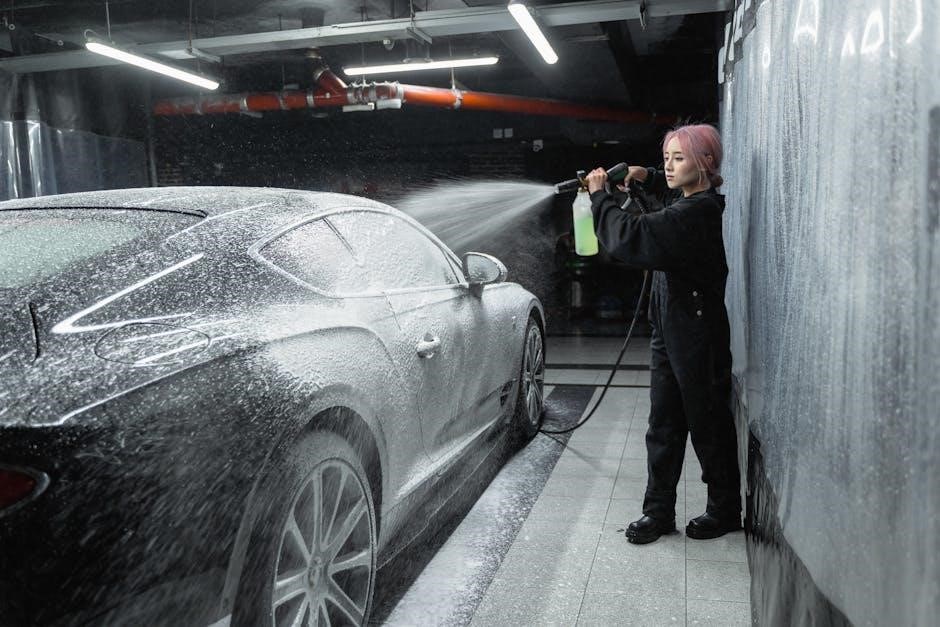
References
For further details, visit Ryobi’s official website or trusted resources like ManualsLib. These platforms offer comprehensive manuals, guides, and troubleshooting tips for optimal performance and maintenance.
11.1 Official Ryobi Websites
11.2 Recommended Additional Resources
Beyond official sources, platforms like ManualsLib offer extensive libraries of Ryobi pressure washer manuals. Forums and community groups dedicated to power tools and outdoor equipment often share user experiences, tips, and troubleshooting advice. Additionally, YouTube channels and DIY websites provide video tutorials and in-depth guides for specific models. These resources complement the official manual, offering practical insights and real-world applications. They are invaluable for users seeking hands-on advice or alternative perspectives on optimizing their pressure washer’s performance and maintenance.
